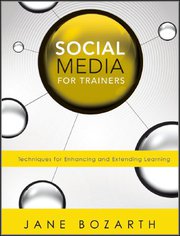 Welcome to the seventh stop of the Blog Book Tour for Jane Bozarth's new book, Social Media for Trainers. If you have been following the blog book tour, then you know Jane's book not only provides an introduction for understanding how to use social media tools, such as blogs, Facebook, Twitter, and wikis; but is also chock-full of examples. And these examples are quite important as they provide models for learning.
Welcome to the seventh stop of the Blog Book Tour for Jane Bozarth's new book, Social Media for Trainers. If you have been following the blog book tour, then you know Jane's book not only provides an introduction for understanding how to use social media tools, such as blogs, Facebook, Twitter, and wikis; but is also chock-full of examples. And these examples are quite important as they provide models for learning.
However, perhaps you are still somewhat leery of using social media for learning, thus I'm listing a few points for you to consider.
We often think of new technologies or concepts as being silver-bullets or replacements for present training and learning initiatives. Past examples include video tapes and elearning. And yes, sometimes they are able to stand by themselves as the learning platform; however, they often work much better in blended solutions. Thus, social media should not normally be thought of as a stand-alone solution, but rather as extensions of face-to-face exchanges in order to extend the learners' networks.
Social media can provide a virtual bridge by acting as the common learning environment (see Instructional Design — Social Learning and Social Media). Thus it extends and in some instances may replace the required social interactions that takes place in a lot of learning processes.
As noted earlier, examples provide learners with real models. Social learning works in a similar manner in that it allows the learners to perceive others for comparison and self-evaluation. In addition, we can bounce ideas off of them and are often a neutral source of information, which may help or speed several forms of instrumental learning (Conte, Paolucci, 2001). We know these social interactions are important because while we might picture someone learning informally as being a “lone learner,” studies have shown that during an informal learning episode a learner normally interacts with an average of 10 people (Tough, 1999). And even though you might only be interested in formal learning, you have to support these informal learning episodes because informal and formal learning are closely tied together — an average of one-hour of formal learning spills over to four-hours of informal learning (Cofer, 2000).
Thus to transform training from an event to a real process you have to support the informal learning that accompanies the majority of formal learning. Bell (1977) used the metaphor of brick and mortar to describe the relationship of formal and informal learning. Formal learning acts as bricks fused into the emerging bridge of personal growth. Informal learning acts as the mortar, facilitating the acceptance and development of the formal learning. He also noted that informal learning is not a replacement for formal learning processes as it is this synergy that produces effective growth.
To make training an effective process, you really have think about tying the various parts of learning into a whole, such as formal and informal learning, and the social learning that normally needs to accompany the other two. While the main reason for training failing in the past was most likely the failure to link formal learning to a real business need, I would think with all the emphasis on it the last few years that we have now gone beyond that and we now need to refine our efforts. Jane's book can be an important part of the solution.
Next stop for the Social Media for Trainers Blog Book Tour is Gina Schreck, that is scheduled on September 22.
You can follow Jane on Twitter: @janebozarth and @SoMe4Trainers; connect with her Facebook pages: Jane Bozarth Bozarthzone and Social Media for Trainers; or read some of her thoughts and ideas on her blog.
References
Bell, C. R. Informal Learning in Organizations. Personnel Journal, 56, no. 6 (June 1977): 280-283, 313. (EJ 160 136).
Cofer, D. (2000). Informal Workplace Learning. Practice Application Brief. NO 10. U.S. Department of Education: Clearinghouse on Adult, Career, and Vocational Education.
Conte, R. & Paolucci, M. (2001). Intelligent Social Learning. Journal of Artificial Societies and Social Simulation. vol. 4, no. 1.
Tough, A. (1999). Reflections on the study of adult learning. Paper presented at the 3rd New Approaches to Lifelong Learning (NALL) Conference, University of Toronto: Ontario Institute for Studies in Education, Toronto, Canada. Retrieved January 8, 2008 from http://www.oise.utoronto.ca/depts/sese/csew/nall/res/08reflections.pdf
2 comments:
Thanks so much for providing a tour stop, Don! To echo your comments, we are finally at a place where technology and learner abilities/interests have intersected. This smooths the way for L&D professionals to finally get into those spaces between scheduled, formal learning events where so much real, informal learning happens.
Great post. Thanks for sharing it. True, to make training an effective process, you really have think about tying the various parts of learning such as formal and informal learning, and the social learning that normally needs to accompany the other two.
Post a Comment